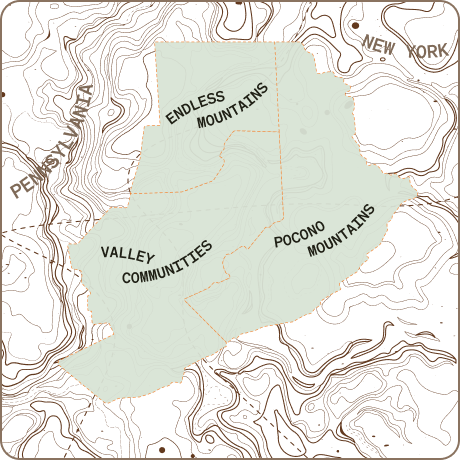Up to 200 Bald Eagles Will Migrate to the Area
Surrounded by NEPA’s Pocono Mountains to one side and New York’s Catskills on the other, the Upper Delaware River has always drawn visitors with its pristine, rustic beauty. They come to kayak the river, fish the bountiful waters and hike the endless trails. But long after the summer vacationers have packed their bags, the area welcomes a different set of guests—bald eagles.
Every winter, about 150 to 200 bald eagles migrate to the Upper Delaware River watershed. When the lakes and rivers up north start to freeze over, they come down to Pennsylvania and New York. Here, the warmer open waters provide a reliable source of fish, while the serene woodlands offer a place to rest during the long, cold months. Some eagles will fly over 900 miles just to spend winter in the area.
Thousands of people come to view these magnificent birds during the Delaware Highlands Conservancy’s annual Eagle Watch. Throughout January and February, visitors shake off the cabin fever and brave the crisp, cold mountain air for a chance to see these amazing creatures in the wild. It takes lots of patience (and really warm socks), but when they finally spot an eagle perched among the frosty trees or soaring over the river, it’s a truly unforgettable sight.
From Threatened to Thriving

Once an endangered species, the bald eagle has made an incredible comeback.
According to the Pennsylvania Game Commission, only three bald eagle nests were left in Pennsylvania in 1983. And it wasn’t just here—throughout the entire nation, only a few hundred remained in the wild due to habitat loss and harmful chemicals like DDT. Restoration programs in the ‘80s helped to reintroduce bald eagles to Pennsylvania, and their numbers have been increasing ever since. Today, the state is home to over 300 active nests.
While it was once a rarity to see an eagle, the Eagle Watch now makes it an annual tradition. The program was started by the Eagle Institute, a nonprofit that merged with the Delaware Highlands Conservancy in 2012.
“Every year, people are just so excited to get to see eagles in the wild,” said Bethany Zarnowski, Communications and Development Manager at the Delaware Highlands Conservancy. “For many people, they remember when it was really uncommon to see them. It’s great to see this enthusiasm from people—kids and adults of all ages—to get to see that every year.”
How to View the Eagles

Take a guided tour or embark on a self-guided adventure.
For the full experience, join one of the Eagle Watch Bus Tours, where an expert guide takes visitors to the key viewing spots in Pennsylvania and New York.
The tours have become so popular that they sell out every year, so be sure to make an advance reservation.
You can also take a self-guided tour. The Delaware Highlands Conservancy sets up observation areas at the eagle hotspots throughout the region (which you can find on this map). Early morning and late afternoon are the best times to spot them.
“Our volunteers go out to the observation areas on the weekends in the winter and help people look for eagles. We have a great group of volunteers who help us with that,” said Zarnowski.
A winter field station is located at the Zane Grey Museum, where you’ll find fascinating exhibits, visitor information and a viewing area along the Lackawaxen River. The field station is open every weekend now through the end of February.
You’ll definitely want to bundle up and bring binoculars for the best views. But most of all, you’ll want to make sure that you’re respecting nature.
“We have eagle etiquette tips posted on our website,” Zarnowski explained. “You want to make sure that you’re not disturbing them and forcing them to fly. That uses the energy that they’re trying to conserve, especially in the winter.”
Protecting Eagles, Protecting the Earth

The Delaware Highlands Conservancy preserves the forests and waters that make this area special.
Habitat loss still remains the top threat to bald eagles today. That’s where local nonprofits like the Delaware Highlands Conservancy step in to help. This land trust works with landowners to protect the forests, farmland and waters of the Upper Delaware River region. To date, they’ve protected over 18,000 acres.
The Van Scott Nature Reserve in Beach Lake is one of the conservancy’s most recent successes. The 144-acre property is home to about three miles of walking trails, as well as the conservancy’s main office.
“The Reserve is a beautiful place for hiking year-round, with scenic trails through the forests, wildflower meadows, and wetlands. It’s a great place for hiking, cross-country-skiing, or snowshoeing in winter,” Zarnowski said. To protect wildlife habitat, the Conservancy does not allow dogs on the Reserve.
Clean water and healthy habitats not only benefit the eagles—they’re vital to all living things, humans included. Get involved and help preserve NEPA’s landscapes for generations to come. The Delaware Highlands Conservancy welcomes volunteers of every interest and talent, whether you’re manning an observation area at the Eagle Watch, maintaining trails at the reserve or pitching in with office work. As a member-supported organization, the conservancy also relies on donations to continue their mission. Visit their website to learn more about how you can help.
Article Updated from its Original Version Published on 1/10/22.




















